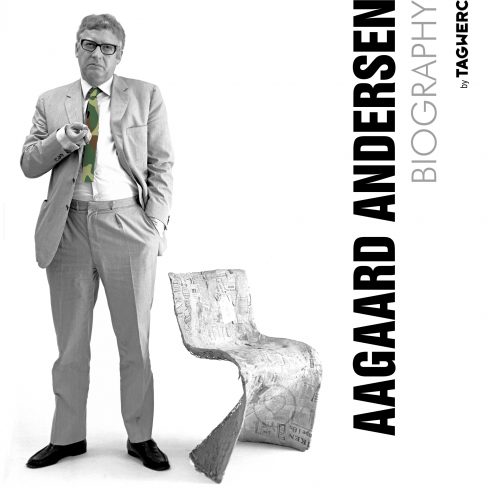
Gunnar Aagaard Andersen
Gunnar Aagaard Andersen (1919 – 1982) was a Danish sculptor, artist, painter, sculptor and graphic artist who also worked in the field of architecture and interior design. Aagaard Andersen belongs to the Scandinavian Avant-garde and his designs can be attributed to the style of the Concrete Art Movement. He is regarded as the pioneer and basis of designs by many artists and designers. Designs by Gunnar Aagaard Andersen are now represented in renowned design collections and are exhibited in museums worldwide, including the Museum of Modern Art (MoMA), New York, USA.
Geometric patterns and colour theory
Gunnar Aagaard Andersen’s works are characterized by his research attitude, which lasted throughout his lifetime. Aagaard Andersen studied the laws of science and explored the resulting possibilities for design and art. In this way, Andersen drew and formed paintings and sculptures, which were composed of many identical, partly graphic elements. As early as the late 1940s/ early 1950s, Andersen drew patterns composed of geometric shapes and conducted studies on colour theory – long before some of his compatriots jumped on this bandwagon.
Sculptural chairs
As a visual artist, sculptural forms were one of Aagaard Andersen’s special strengths. The Dane experimented with paper that can be bent, folded and torn, and first processed these techniques in paintings. In 1952, he formed a seat sculpture made of wire, which depicted the negative shape of his own hindhand as a seater, and covered this scaffold with pieces of paper from a daily newspaper. This form finding of a so-called ‘Kragstuhl’ was based on the principle of papier-maché, which was often used for the production of models and at that time had a similarly important role as plastics today. This chair, which Aagaard Andersen did not name, was completed in 1953 and presented in exhibitions and the magazine ‘mobilia’. It is immortalized in the book “1000 Chairs” by Charlotte and Peter Fiell. It says, “Prototype of wire mesh and newsprint, should be made of pressed aluminium or fiberglass-reinforced plastic.” The form was so new that Aagaard Andersen’s compatriot Poul Kjaerholm interpreted it with his own chair. It is part of the collection of the Danish National Museum, which represents the cultural history of Denmark.
“Portrait of My Mother’s Chesterfield Chair”
Gunnar Aagaard Andersen worked tirelessly and went beyond the boundaries of traditional visual arts. In the 1960s, Aagaard Andersen discovered polyurethane and created the „Portrait of My Mother’s Chesterfield Chair“ armchair, an unconventional armchair that was completed in 1964 and is exhibited at MoMA.
Aagaard Andersen and other artists, designers and architects
Aagaard Andersen was popular in the artistic scene and is known with a variety of architects, designers and artists. As the founder and member of several artist movements, the designers of his time went in and out of his studio and residence, the Munkeruphus in the Danish coastal town of Dronningmélle-Hornbæk. Since the 1930s, the area in the northern region of Zeeland has been a popular summer dependency for Danish artists and designers. The architect and designer Poul Henningsen also maintained a summer house here. Verner Panton, who was married to Henningsen’s stepdaughter in 1950, later bought a summer house in Hornbæk.
Danish design scene in the 1950s
And also at the Danish fabric producer Unika-Væv, whose logo Aagaard Andersen designed and where he worked, the threads in the Danish design scene have been converging since the 1950s. In 1955, Aagaard Andersen designed the logo for the Danish design magazine ‘mobilia’, which was mainly based on furniture, but also on interior design, architecture and art. Here he presented some of his designs and worked for the magazine until his death. ‘Letters’, arguably Aagaard Andersen’s best-known fabric design, was also produced in 1955.








